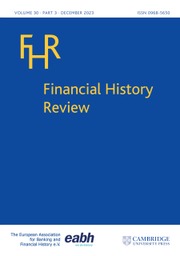For the shareholders of a private company, dividends regulate the balance of cash holdings versus the amount invested in the stock. For shareholders with insufficient income from other sources, the dividend supports consumption, while for resourceful shareholders the dividends must be invested elsewhere. A shareholder vote is the natural mechanism to resolve the conflict of interest between those who rely on dividends for consumption and those who don't, which means that the majority decides.
The shareholders of a public company can regulate the cash balance on their own by selling and buying shares. Those in need of cash for consumption can sell, and those with sufficient income from other sources can reinvest the dividend. As a result of the option to alter the cash balance by trading the stock, whatever the company decides to do, dividend policy is a matter of irrelevance (Miller and Modigliani Reference Miller and Modigliani1961).
The literature focuses on explaining dividend policy in modern stock markets, where shareholders have the option to trade their shares. Personal income tax tilts the balance in favor of capital gains over dividends as shareholders can time the payment of personal income taxes and, in many tax environments, pay taxes at a lower rate (Black Reference Black1976). Asymmetric information between the manager and outside shareholders tilts the balance in the other direction as dividends may convey inside information (Bhattacharyya Reference Bhattacharyya1979) or restrict managers’ control over free cash flows (Jensen Reference Jensen1986). Non-standard preferences and bounded rationality may also favor dividends over capital gains (Shefrin and Statman Reference Shefrin and Statman1984; Shefrin and Thaler Reference Shefrin and Thaler1988). For historical markets, there is also the argument that companies attract outside investors by mimicking the cash flows of bonds (Baskin Reference Baskin1988).
The objective of this article is to study dividend policy in a comprehensive sample of Swedish listed companies for the period 1912–78. We provide new evidence that dividend policy matters to the shareholders of publicly listed companies in historical stock markets. We also propose the hypothesis that dividends generate essential income for shareholders with few shares in their stock portfolios. Small stock portfolios are an important characteristic of early stock markets in Sweden.
First, the Swedish Company Law of 1910 prescribed that management propose a dividend (or no dividend) to the annual shareholder meeting. Almost always, shareholders approved the proposed dividend, but in a few cases (18 observations out of 8,000), shareholders rejected the management proposal and changed the dividend per share. Disagreement over the dividend per share cannot occur in a frictionless market. This evidence of dividend policy relevance may not be overwhelming in number, but it is unambiguous.
Second, Swedish companies routinely ask existing shareholders to purchase new shares at the same time as they maintain the dividend per share. In addition, issuing companies carefully point out whether the new shares are entitled to or excluded from receiving the next dividend, and some issuers even specify whether the new shares are entitled to a portion of the next dividend. The meticulous treatment of dividends in the context of rights offers suggests that dividends matter to the shareholders of the issuing company. The payback time is only three years, i.e. companies return the new issue proceeds to shareholders in the form of dividends after only three years. Replacing after-tax stock investments with before-tax dividend income certainly matters under personal income tax. Cutting dividends would be a low-cost alternative to financing corporate investments (Black Reference Black1976; Loderer and Mauer Reference Loderwer and Mauer1992).
Third, shareholders prefer predictable dividends that facilitate financial planning. We reiterate a large empirical literature that shows how managers smooth dividends relative to earnings (Lintner Reference Lintner1956) and carefully point out whether a dividend is regular or special (Brickley Reference Brickley1983; DeAngelo et al. Reference Deangelo, Deangelo and Skinner2000). Swedish companies take one additional step to enhance predictability. When they increase the number of shares through stock dividends, they increase the total dividend payout in proportion to the increase in the number of shares, which implies that the dividend per share remains constant. A widespread technique is to pay a special dividend to old shares that is proportional to the increase in the number of shares. In this way, the new shares receive the current dividend before they have been issued.
Fourth, a few Swedish companies, primarily banks and insurance companies, divide the annual dividend into an interest portion that is paid towards the end of the fiscal year and a profit portion that is paid at the annual general meeting that follows the fiscal year. The underlying interest portion is smaller and less volatile than the profit portion and, as such, provides additional predictability for shareholders. Dividing annual dividends into interest and profit is known from other countries across Europe, but it is an administratively complicated procedure that does not survive.Footnote 1
Fifth and finally, another common practice is to pay a special dividend in celebration of a significant milestone such as the company's 100th birthday. The special dividend has the flavor of a birthday cake or present to shareholders. This seemingly odd behavior suggests that shareholders appreciate the special dividend that allows them to increase spending.
While dividend policy obviously matters in a private company, where shareholders do not have the option to sell or buy shares, it is a bigger challenge to explain what determines the dividend policy of a public company. In what follows, we ignore the plethora of modern approaches to dividend policy and focus on the restriction that one share of a company stock cannot be purchased or sold in fractions. We advance the hypothesis that dividends meet the consumption needs of investors with few shares in their stock portfolios.
An example illustrates the argument. A shareholder with five shares in their portfolio chooses between selling one share at the price of 200 kronor or receiving a cash dividend in the amount of 8 kronor per share. The sale of one share results in a cash balance of 200 kronor and 800 kronor invested in stocks, while the dividend results in a cash balance of 40 kronor and 960 kronor invested in stocks. The two outcomes are not equal. In a liquid market with multiple investment opportunities, the investor can simply reinvest the excess cash in a similar stock. However, in historical markets, where stock prices were exceedingly high relative to income and most listed Swedish stocks did not trade much (Rydqvist and Guo Reference Rydqvist and Guo2021), the only feasible alternative may have been to deposit the excess cash in a bank account, which is not equivalent to holding stocks. In other words, while handling cash dividends may be a nuisance for institutional investors in modern stock markets, handling the proceeds from selling shares may have been a nuisance for retail investors in historical stock markets. A regular and predictable dividend resolves the individual's consumption-savings problem in a cost-efficient manner.
What do stock portfolios look like? We retrieve individual stock portfolio data from subscription lists in rights offers by Swedish listed companies for the period 1912–35. Many investors participated with the minimum number of shares that were required to purchase one new share (most of the time two, three, or four old shares). As many as 60 percent of rights offer participants had 25 shares or fewer. This statistic provides an incomplete description of the number of shares in stock portfolios, but it suggests that the number of investors with small stock portfolios was considerable. Stock portfolios were small because the price per share was high relative to income, and many investors did not have the financial means to purchase many shares. In Stockholm 1920, stock prices ranged from 25 to 10,000 kronor with a mean around 500 kronor per share. An average worker earned 4,000 kronor per year, a pharmacist 15,000 kronor and a physician 25,000 kronor. For a worker, buying a single share was a substantial financial undertaking. Buying a well-diversified stock portfolio may have been financially challenging also for a physician. As time passes, the price per share decreases through stock splits and inflation. By 1978, the average price per share in real terms was only 10 percent of the average price per share in 1912, and the problems associated with selling shares in discrete quantities were less.
Studies of historical stock markets find that most listed companies paid dividends, time-series of dividend per share were stationary and dividends were smooth relative to earnings.Footnote 2 Researchers investigate to what extent dividend policy can be explained by information asymmetries, agency problems and legal investor protection. These theories that have been derived from information economics are broadly consistent with the general observations that listed companies pay stationary and predictable dividends, but existing theories are too general to explain the specific features of dividend policy in Sweden, notably, dividend revisions, the continued and elaborate treatment of dividends in rights offers, special dividends around stock dividends, the practice to decompose dividends into interest and profit of unequal size and volatility, and the celebration of a big birthday with a special dividend. We propose the more fundamental explanation that shareholders rely on dividends for consumption.
The subscription lists suggest that a large percentage of stock market investors owned few shares, and it was these investors for whom dividends mattered the most. Ownership data are also available from the United Kingdom. Acheson et al. (Reference Acheson, Campbell, Gallagher and Turner2021) study the stock ownership structure of three railway companies in England during the period 1915–22. Between one-third and two-thirds of the shares were held by groups of two or more individuals who entered an agreement to purchase one share of stock together. Presumably, these mutual funds held a single share. Furthermore, in a study of probate records from England and Wales between 1870 and 1902, Sotiropoulos and Rutterford (Reference Sotiropoulos and Rutterford2018) find that 90 percent of deceased individuals had 10 securities or fewer, although the paper does not specify the number of shares of each security. These papers express a concern that individuals with few shares in their investment portfolios may have been underdiversified. We add the argument that individuals with few shares in their portfolios may have planned on the annual disbursement of dividends for consumption.
I
We need data on dividends and capital operations. The Official Quotation List of the Stockholm Stock Exchange states the dividend per share. It also specifies whether a dividend is regular or special. We verify all dividend information against companies’ annual reports, where we also find verbal explanations of why the dividend is special. We identify dividend revisions by comparing the proposed dividend according to the annual report with the actual dividend according to the Official Quotation List.
We collected the rights offer terms from a variety of data sources: new issue advertisements in a business magazine (Affärsvärlden), an official government bulletin (Post- och Inrikes Tidningar) and the historical archive of Stockholms Enskilda Bank at the Centre for Business History (Centrum för Näringslivshistoria). We collected additional information from the original files with the Swedish Companies Registration Office, the Swedish National Archives, annual reports and the Official Quotation Lists. The original rights offer files include subscription lists that we used to count the number of shares in stock portfolios.
We identify stock splits as changes in the par value per share and a simultaneous drop in the price per share. Stock splits are also mentioned in the annual reports. Two annals, Svenska Aktiebolag (1901–77) and Aktieägarens Uppslagsbok (1938–46), summarize the evolution of capital, and they explain whether a change in the firm's capital is the result of a new issue or a stock dividend. We collected further information about stock dividends from the Official Quotation Lists and companies’ annual reports. A stock dividend is the subject of shareholder approval and, for the most part, it is decided at the general meeting together with the annual dividend.
II
Rydqvist and Guo (Reference Rydqvist and Guo2021) analyze the performance and development of the Stockholm Stock Exchange for the period 1912– 2017. This long time period is characterized by persistent real growth that was only briefly interrupted by the Deflation Crisis of 1921–2 and the beginning of the Great Depression in 1932. In the remainder of this section, we summarize background information of particular interest for the analysis of dividend policy.
The cross-section consists of approximately 100 listed companies. Listed equity securities include preferred stocks, common stocks and deferred stocks. Common stocks are further divided into stocks with differential voting rights of which some are restricted to domestic ownership. In our analysis, we aggregate the dividends that are paid to all classes of stocks of a company. We do not pay attention to the complex cash flow structures of preferred and deferred stocks.
Average company age is high, and it increases as we move forward in time because few companies de-list and few companies enter. In 1978, the equal-weighted average listing time was close to 40 years. Average firm size grows at the rate of the economy, which means that average firm size in 1978 equals approximately eight times average firm size in 1912. By 2017, average firm size equals 30 times the average of 1912. These statistics suggest that the median listed company can be characterized as large and mature.
The primary stock market is liquid, while the secondary market is illiquid. In 1912, only one stock traded every day compared to 1978, when most listed stocks traded regularly. Throughout the studied period, annual turnover in the secondary market was less than 10 percent of the number of shares outstanding. In 1920, individual shareholders owned 81.5 percent of the stock market, and organizations the remaining 18.5 percent (Rydqvist Reference Rydqvist2024). Most organizations were small private companies that were most likely owned by a single or a few individuals. In 1920, there were three corporate group structures. The best known is Kreuger & Toll. In 1929, the Wallenberg Group was formed and much later, in 1960, the Group of Svenska Handelsbanken. Institutional investors slowly replaced stock ownership by individuals (Rydqvist et al. Reference Rydqvist, Spizman and Stebulaev2014). Banks were not allowed to own shares.
Corporations also issued bonds. In 1912, approximately 15 percent of corporate balance sheets were bonds, but the percentage diminished over time. Many corporate bonds were listed on the Stockholm Stock Exchange, but there was no secondary market trading. Presumably, corporate bonds were sold in the primary market to banks, insurance companies and high-income individuals, but we do not have any bond ownership data to verify this conjecture.
Dividends and capital gains were subject to personal income tax. From 1912 to 1990, dividends were taxed as ordinary income. Top statutory tax rates jumped in 1938 before the upcoming war (Rydqvist and Guo Reference Rydqvist and Guo2021). Between World War II and the tax reform of 1991, effective marginal tax rates increased by the combined effects of inflation and non-indexation of tax tables (bracket creep). Effective marginal tax rates approached top statutory rates above 80 percent in the 1960s. From 1903 to 1976, long-term capital gains as defined by a holding period of five years were exempt from income tax. From 1977 to 1990, 40 percent of long-term capital gains, now defined by a holding period of two years, were taxed as ordinary income.
The Swedish Company Law of 1910 built on the par value of common stocks and the protection of paid-up capital. The first revision in 1944 imposed stricter accounting standards, and the next revision in 1975 abandoned the par-value system. Par values were strictly enforced: (i) new shares could not be issued below a high minimum par value and (ii) dividends could not be paid from capital or capital surplus. A large number of court cases, where listed companies offset accumulated losses against capital and issued preferred stocks to cover the equity shortfall, suggest that par values were enforced. In conclusion, legal investor protection neither improved nor deteriorated over the studied period.
III
Dividend policies of Swedish listed companies was stable between 1912 and 1978. The stability of dividends makes an interesting contrast to the time-series changes in personal income tax and secondary market trading volume.
We begin with a plot of the time-series of aggregate dividend yield (Figure 1), which is approximately stationary around a mean of 4.30 percent (Rydqvist and Guo Reference Rydqvist and Guo2021).
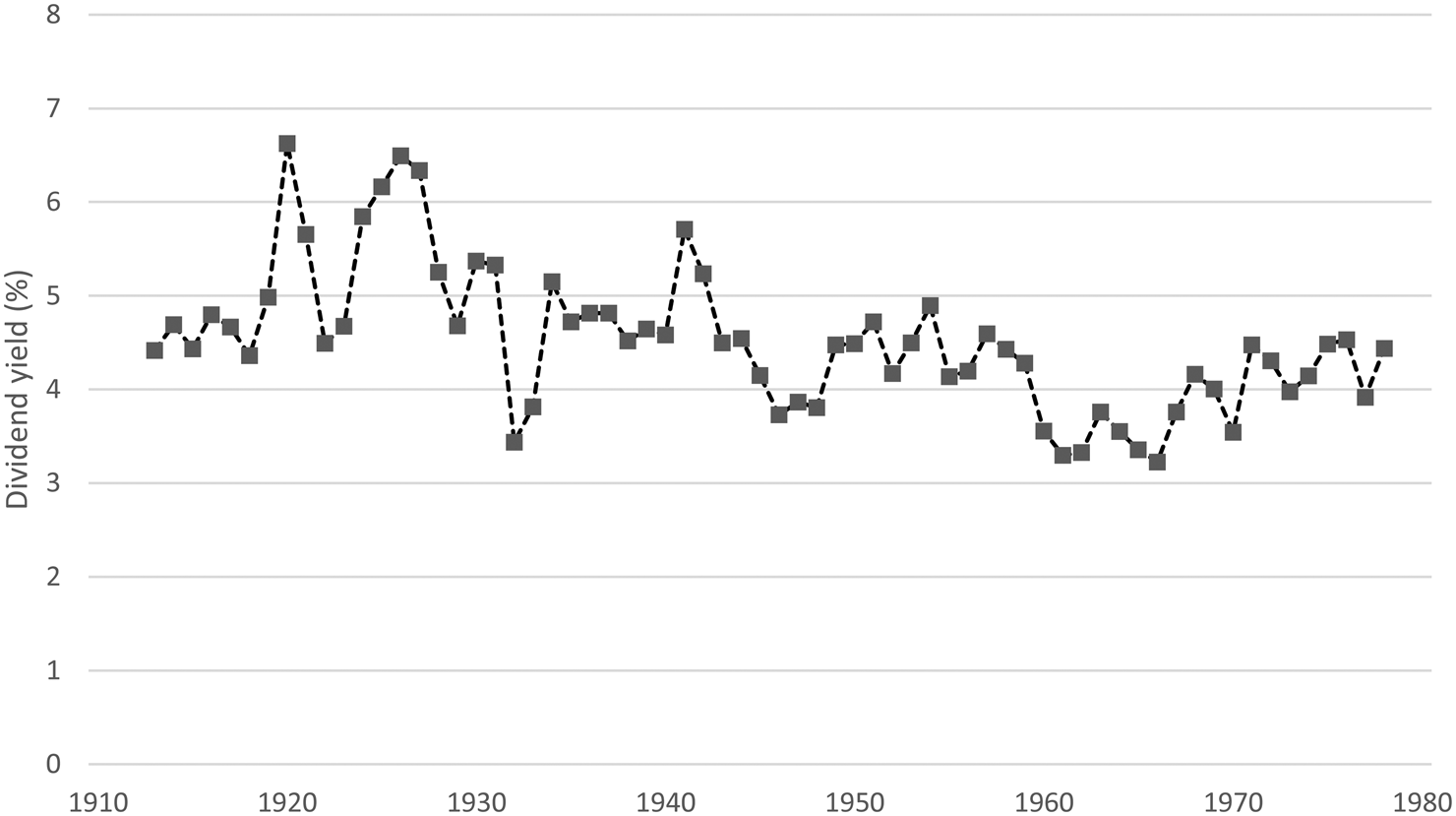
Figure 1. Aggregate dividend yield of Swedish listed stocks, 1912–78
The figure reports the time-series of the aggregate dividend yield, which we estimate as the sum of cash dividends paid during the year divided by the stock market capitalization at the beginning of the year.
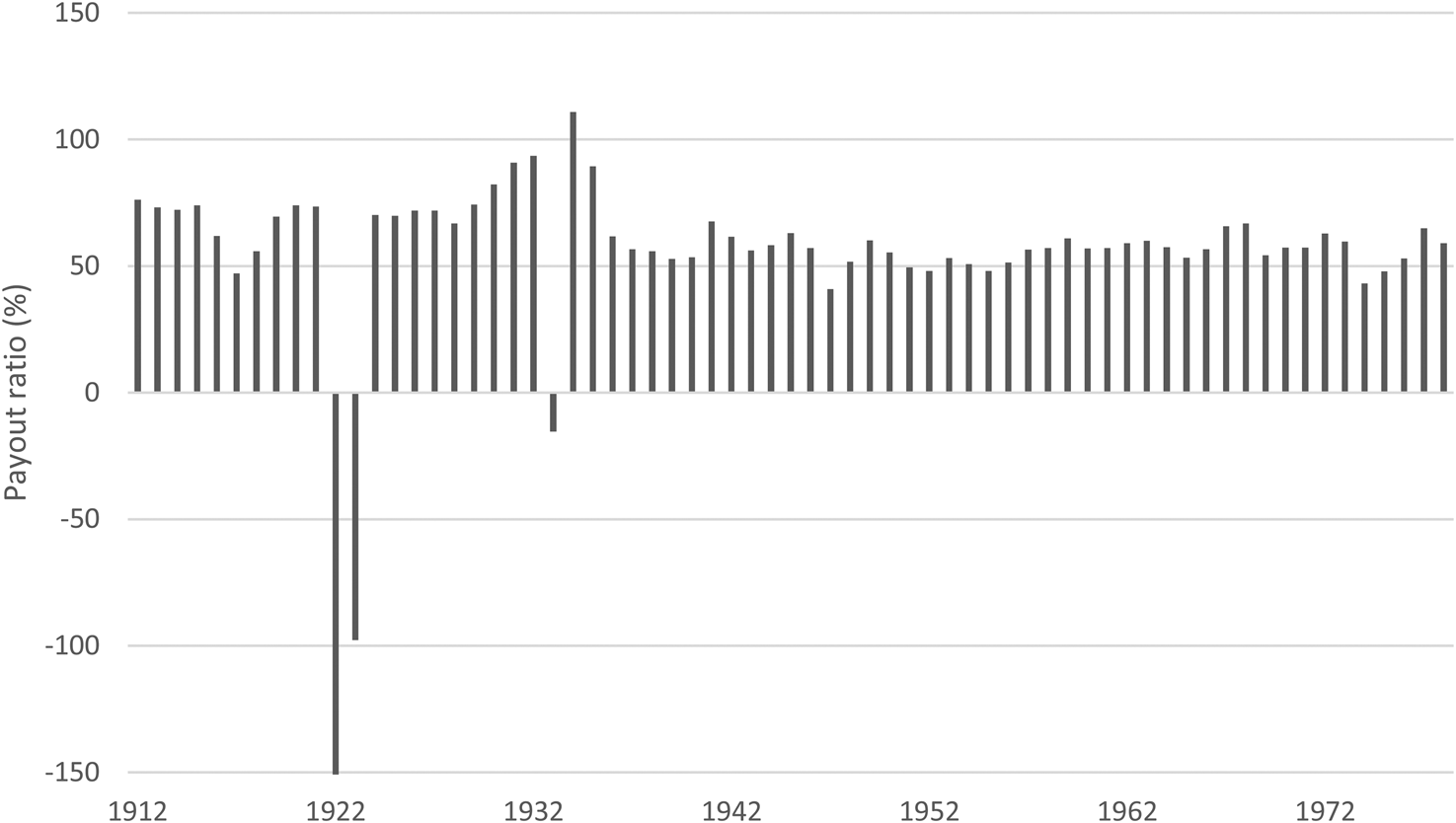
Figure 2. Aggregate payout ratio of Swedish listed stocks, 1912–78
The figure reports the aggregate payout ratio, which we estimate as the sum of cash dividends paid during the year divided by the sum of earnings in the same year. We have truncated the plot at –150 percent. The minimum payout ratio is –190 percent.
The time-series of aggregate dividends as a percentage of aggregate earnings is also approximately stationary (Figure 2). The time-series is broken by the Deflation Crisis of 1921–2 and the beginning of the Great Depression in 1932, when most listed companies paid dividends despite negative aggregate earnings. About 40 percent of the listed companies discontinued their dividends during the Deflation Crisis and 30 percent omitted paying dividends at the beginning of the Great Depression (Rydqvist and Guo Reference Rydqvist and Guo2021). If we ignore the three years with negative aggregate earnings, the average payout ratio equals 75 percent before 1935 and 56 percent after. The time-series reduction in the average payout ratio could be the result of better investment opportunities, less reliance of external equity financing, or a change in the accounting definition of profit. Growth rates picked up after World War II, new issue volume decreased notably after the Deflation Crisis of 1921–2 (Rydqvist and Guo Reference Rydqvist and Guo2021) and accounting methods changed. Before 1935, companies depreciated assets freely, and fast accounting depreciation may have kept earnings low. In addition, many companies reported earnings net of after-tax appropriations. Examples include reservations for social security purposes such as widows’ pensions, disability insurance, funds for a local school, etc. From 1936 and into modern times, these accounting appropriations became redundant when the public social security system developed.
We illustrate dividend policy at the individual firm level with a typical time-series (Figure 3). The company SKF manufactured ball bearings, which were in high demand for machines with wheels such as cars, trucks and tanks. The plot stresses four features. First, SKF was a financially successful company with positive earnings and dividends every year except during the Deflation Crisis of 1921–2. Second, the time-series of earnings and dividends per share are stationary as a result of meticulous stock price management through stock splits and stock dividends that increased the number of shares at the same rate as the company assets grew (8 percent per year). Third, the time-series of earnings and dividends are visibly correlated, i.e. dividends increase when earnings increase. Fourth and finally, earnings are more volatile than dividends (smoothing).
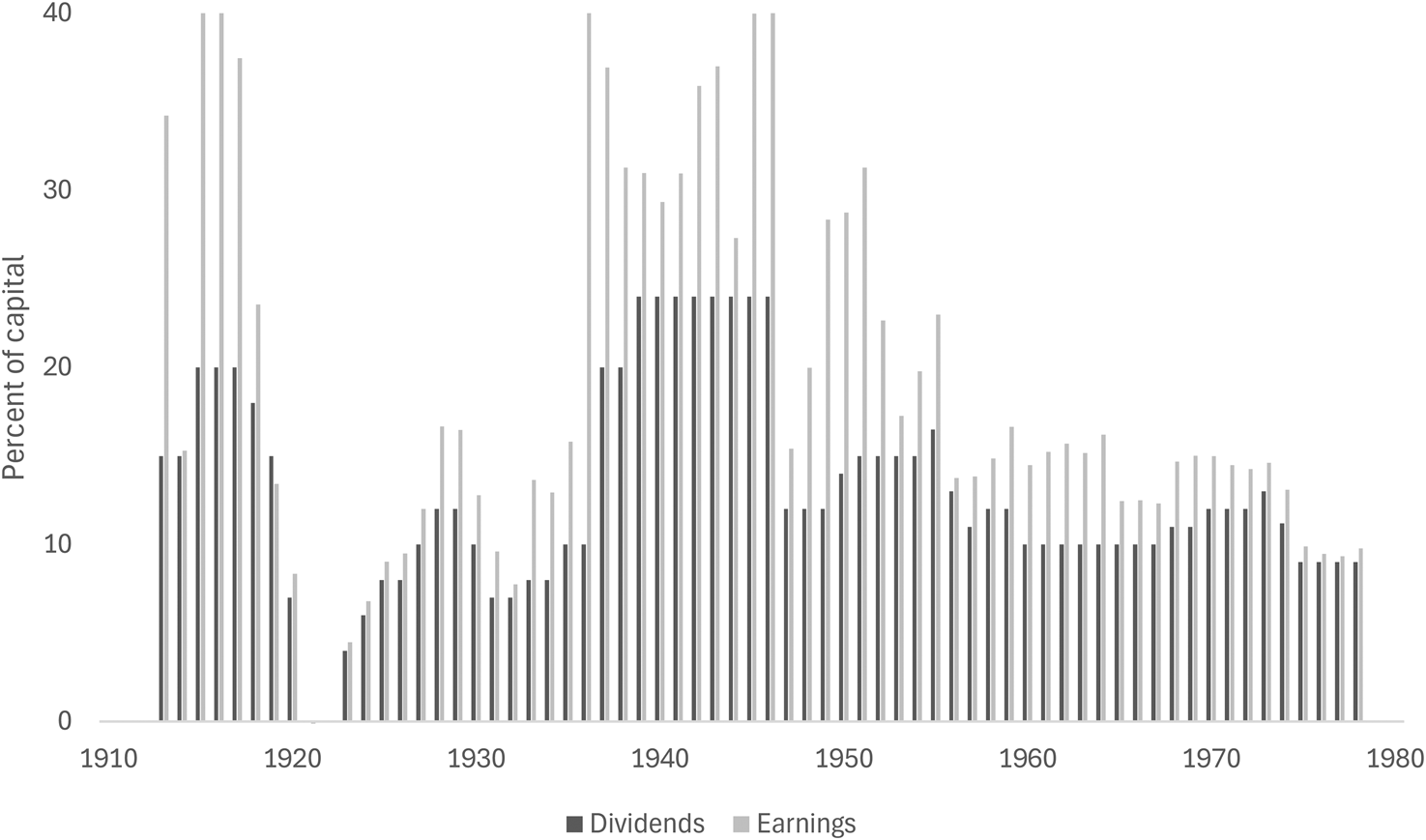
Figure 3. Dividend policy of SKF, 1913–78
The figure plots the time-series of earnings per share (light-gray columns) and dividend per share (dark-gray columns). The ratio of dividend per share to earnings per share equals the payout ratio. We have truncated the vertical axis at zero.
IV
The disbursement of dividends was a shareholder decision. Prior to the annual general meeting, management asked shareholders to approve of the disposition of the profit-and-loss account:
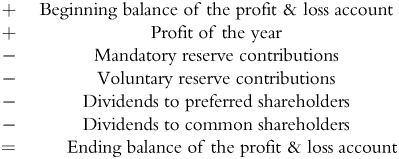
The carry-forward balance from last year plus the profit of the current year were available for reserve contributions and dividends. The law required that the company contributes 10 percent of the annual profit to a reserve fund until the fund reaches a statutory limit. A stock dividend is a voluntary reservation that reduces the profit-and-loss account by the par value times the number of new shares. After these accounting transactions, the company paid dividends to preferred stockholders and to common stockholders in turn. Any remaining balance in the profit-and-loss account was carried forward to the next general meeting.
A simple majority vote decided stock and cash dividends. Dividends to preferred stocks were cumulative, and omitted dividends in the past had to be paid before common stocks received any dividends. Dividends were payable immediately after the shareholder vote. The minimum number of shares required to participate in the annual general meeting was one share. Every share must have voting rights, but the number of votes per shares did not have to be equal. From 1934, the maximum difference in voting rights was ten to one.
In the normal case, shareholders vote with management and approve the proposed disposition of the profit-and-loss account, but there are cases where shareholders disagree with management. Under the standard assumptions of corporate finance theory, there cannot be shareholder disagreement over payout policy because any shareholder can costlessly reinvest excess cash or sell shares to generate additional cash (Miller and Modigliani Reference Miller and Modigliani1961). Given the importance of the irrelevance theorem in research and pedagogy, we list the 18 shareholder meetings, where a majority of the shareholders rejected the management proposal and revised the dividend (Table 1). Most of the time, shareholders wanted the company to raise the dividend (Panel A). There are two cases where management proposed to decrease the dividend and shareholders rejected the dividend cut (ASEA and Ströms Bruk). In 12 other cases, where shareholders wanted to raise the dividend, management proposed the same dividend as last year (nine cases) or management proposed a higher dividend than last year (three cases). In four cases, a shareholder majority voted for a special dividend, which is marked with a plus-sign in the table. These vote outcomes have the flavor of a bargaining compromise between management and shareholders. There are four cases where shareholders request a lower dividend than proposed (Panel B). They have in common that the dividend was omitted either for the current year or the next year. One possible explanation is that there was a time lag between the proposal, which was printed in the annual report, and the shareholder meeting that took place two months later. If negative information arrived between the two dates, management and shareholders may have agreed that the proposed dividend was inappropriate.
Table 1. Dividend revisions, 1912–78
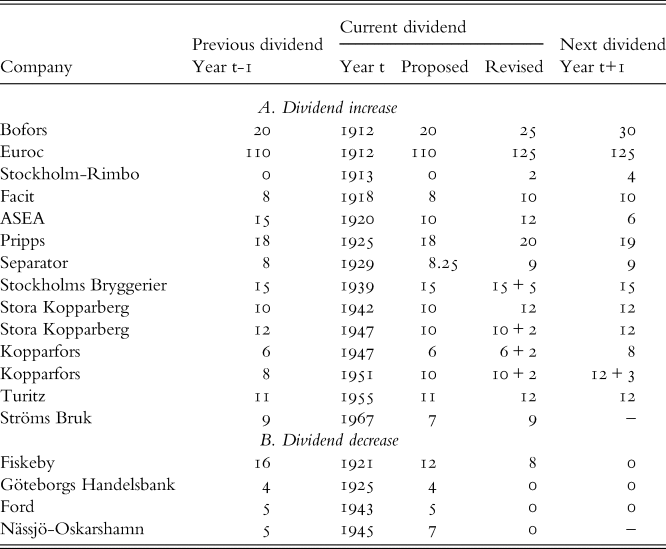
The table lists shareholder meetings where management propose a dividend per share that is subsequently revised. The observations have been sorted by year of appearance. The dividend amount is expressed in kronor per share. The symbol ‘+’ denotes special dividend (bonus).
V
Public Swedish companies paid dividends at the same time as they sold shares. The sample companies made 474 rights offers of common stocks of which 459 companies paid dividends at the same time, 12 did not pay dividends and three companies have missing data. This behavior stands at odds with the behavior of modern companies, which either pay dividends (value stocks) or raise capital (growth stocks), but not at the same time. In this section, we estimate how long it took for investors in the primary market to get their money back in the form of dividends.
We begin with a numerical example. Suppose that management proposes a rights offer of one new share for four old shares at an issue price of 120 kronor per share. The company continues to pay its annual dividend in the amount of 8 kronor per share. We work out the payback time by equating the cost of the new share with the sum of dividends that are paid on four old shares and one new share over the coming x years:
In this example, which has been calibrated to the data, payback time is only x = 3 years. That is, the company returns the new money to shareholders after only three years.
A common practice is to exclude the new shares from the next dividend. Using the numbers of our example, we again work out the payback time:
Payback time increases to x = 3.2 years. A version of this problem is to exclude the new dividends from a portion of the next dividend. If the new shares are entitled to half the next dividend, the equation that determines the expected payback time becomes:
The calculated payback time changes to x = 3.1 years.
The meticulous calculations of payback time in these examples are intriguing. The fact that Swedish companies actually paid attention to such details as excluding the new shares from a portion of the next dividend suggests that every krona counted. The decision to include or exclude the new shares from the next dividend carries through the entire sample period 1912–78. Dividends clearly matter to shareholders.
We proceed by deriving the general expressions for calculating payback time. Let P o denote the new issue offer price, n t is the number of new shares expressed as a fraction of one old share, and D t+1 = D t+2 = … is the expected future dividend per share. When the new shares are entitled to receive the next dividend, the expected payback time is:
When the new shares are excluded from the next dividend, the expected payback time is:
and when the new shares are excluded from a portion of the next dividend, π ∈ (0, 1), payback time is given by:
Frequently, management propose to combine the new issue with a stock dividend. Let m t be the number of new shares distributed to shareholders through the stock dividend. In this case, payback time is shorter:
In equations (4)–(7), payback time refers to the number of subsequent dividends and not to calendar time. The actual time that elapses between the rights offer and the next dividend is likely to be less than a full calendar year. In addition, dividends are paid annually and the solutions to equations (4)–(7) typically imply fractions of a full-year dividend payment. However, the purpose of the calculations is not to generate an exact estimate of payback time, but to make the point that the proceeds from selling new shares are returned to shareholders within a few years. Equations (4)–(7) have been simplified. The total payment for purchasing new shares has three components: (i) the offer price per share P o; (ii) stamp duty; and (iii) interest on payments that take place after the end of the fiscal year. We use the sum of these payments in our calculations. The supplementary material to Rydqvist and Guo (Reference Rydqvist and Guo2021) contains details.
Average payback time is three years when the new shares receive the next dividend (Table 2). It is about one year longer, 3.9 years, when the new shares are excluded from the next dividend. We can compare these numbers to those of limited preferred stocks. If the coupon rate on a preferred stock is 5 percent, payback time is 20 years. From this comparison, we conclude that payback time on common stocks is short. In fact, the payback time on new shares is similar to that of a bank loan.
Table 2. Payback time

The table reports the average payback time conditional on including or excluding the new shares from the next dividend. Time refers to the number of annual dividend payments that return the money to buyers of the new shares.
Subscribers to the rights offer make after-tax investments, while the dividends that the companies return to investors are before tax. With personal income tax τ, equation (1) changes to:
A tax rate of 25 percent raises payback time to x = 4 years, and a tax rate of 50 percent doubles payback time to x = 6 years. We conclude that payback time is short also after taking into account the effects of personal income tax.
VI
Management carefully stated whether a dividend was regular or special. Special dividends appeared about 5 percent of the time. For the most part, a special dividend meant that the dividend was either temporary or uncertain. Special dividends have many labels: (i) bonus dividend (156 observations); (ii) prepaid stock dividend (133 observations); (iii) fiscal year adjustment (29 observations); (iv) jubilee dividend (22 observations); (v) regulatory maximum dividend (11 observations); (vi) make-up dividend for past omitted dividends on participating preferred stocks (10 observations); and (vii) return of capital (seven observations). When a company switched from calendar year to broken year or vice versa, management changed the dividend per share in proportion to the length of the new fiscal year. In response to World War II, the government imposed certain regulations including a cap on company dividends. Once these regulations were abolished, management proposed to make up for the discrepancy between the target dividend and the regulatory maximum. Returns of capital are tax-free distributions of the principal. The aggregate value of special dividends excluding prepaid stock dividends amounted to 6 percent of all dividends paid.
We illustrate the meaning of prepaid stock dividends with an example. From 1930 to 1978, ASEA paid a dividend between 7 and 10 kronor per share (Figure 4). On six occasions, ASEA paid a special dividend in connection with stock dividends. For example, in 1965, management proposed a stock dividend of one new share for four old shares, which implies an increase in the number of shares by 25 percent. Management proposed to the shareholders’ meeting a dividend of 12.50 kronor per share of which 10 kronor was the dividend per old share and 2.50 kronor the dividend for one-quarter of a new share. The special dividend was distributed to the new shares before they were been issued. The other five special dividends have the same construction.

Figure 4. Dividends of ASEA, 1912–78
The figure plots dividend as a percentage of par. The total dividend equals the sum of the regular dividend (dark-gray portion) and the special dividend (light-gray portion). The six special dividends are prepaid stock dividends.
Many Swedish companies celebrate big birthdays with a special dividend (Table 3). The special dividend has the flavor of a birthday cake or a present, something pleasant to consume. This corporate behavior may appear peculiar, but it suggests that shareholders want dividends for consumption. Jubilee dividends continue well into modern times. We also note that Metallverken celebrated 350 years of existence and Stora Kopparberg 600 years.
Table 3. Special dividends to celebrate a jubilee
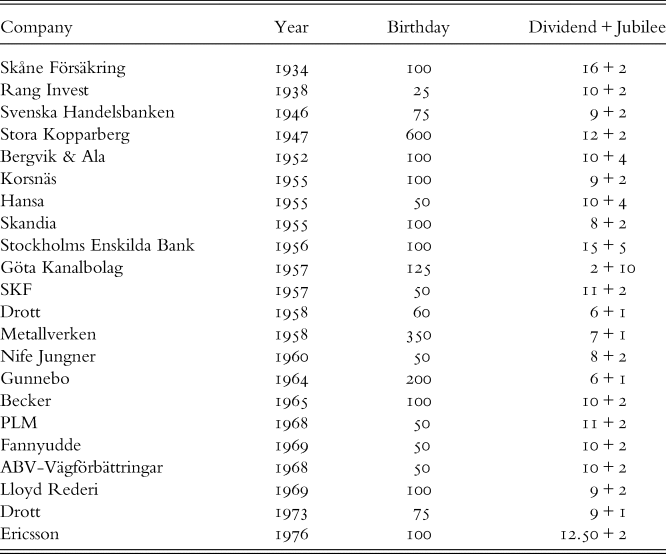
The table lists companies that pay a special dividend to celebrate a jubilee. The symbol ‘+’ denotes special dividend. For comparison across firms, we express dividend as a percentage of par.
VII
Around the turn of the twentieth century, a few Swedish companies, primarily banks and insurance companies, decomposed their annual dividend into ‘interest’ that is paid at the end of the fiscal year and ‘profit’ that is paid at the annual general meeting that follows the fiscal year. Shareholders pre-approved of the next interest payment at the annual general meeting in the spring. Many Swedish companies abandoned their dual-dividend structures during the Deflation Crisis of 1921–2 and the beginning of the Great Depression in 1932, when losses forced companies to omit paying dividends, but some companies removed their dual-dividend structures in good economic times, presumably, to reduce the administrative burden. We proceed with two examples and summary statistics.
From 1912 to 1948, Skandia paid interest that varied between 3 and 6 percent of par (Figure 5). During the same period, the profit component varied between 5 and 11 percent of par. Skandia never missed a dividend payment. The company abandoned the dual-dividend structure in 1949 without reducing total dividends. Like other Swedish companies, Skandia separated regular and special dividends, and the company adjusted dividends around stock dividends.
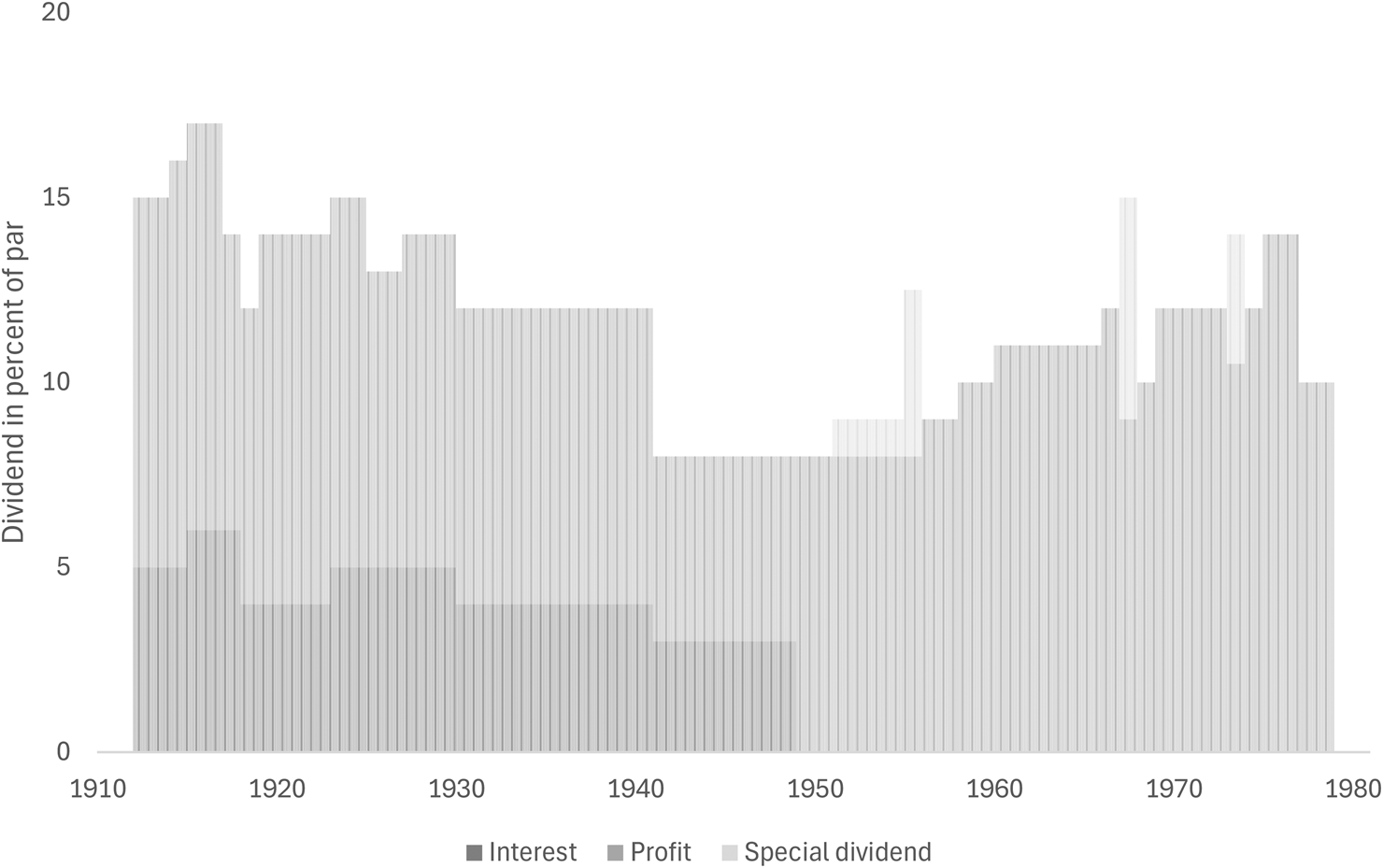
Figure 5. Dividends of Skandia, 1912–78
Skandia is an insurance company. The figure plots dividend as a percentage of par. The total dividend equals the sum of the underlying interest (dark-gray portion), profit (mid-gray portion) and the special dividend (light-gray portion). Interest is paid at the end of the fiscal year, and profit is paid at the annual general meeting following the fiscal year. The special dividends in 1951–4 are bonus dividends; the special dividend in 1955 is a combination of a prepaid stock dividend and the celebration of the company's 100th anniversary; and the special dividends in 1967 and 1974 are prepaid stock dividends.
The interest payment of Stockholms Enskilda Bank was a time-series constant at 5 percent of par, and the profit portion was almost constant at 10 percent of par (Figure 6). In 1937, management proposed a special dividend, which doubled the profit portion of the dividend. The stated motivation in Stockholms Enskilda Bank's annual report was excess liquidity. In 1956, management proposed another special dividend in celebration of the bank's 100th birthday.
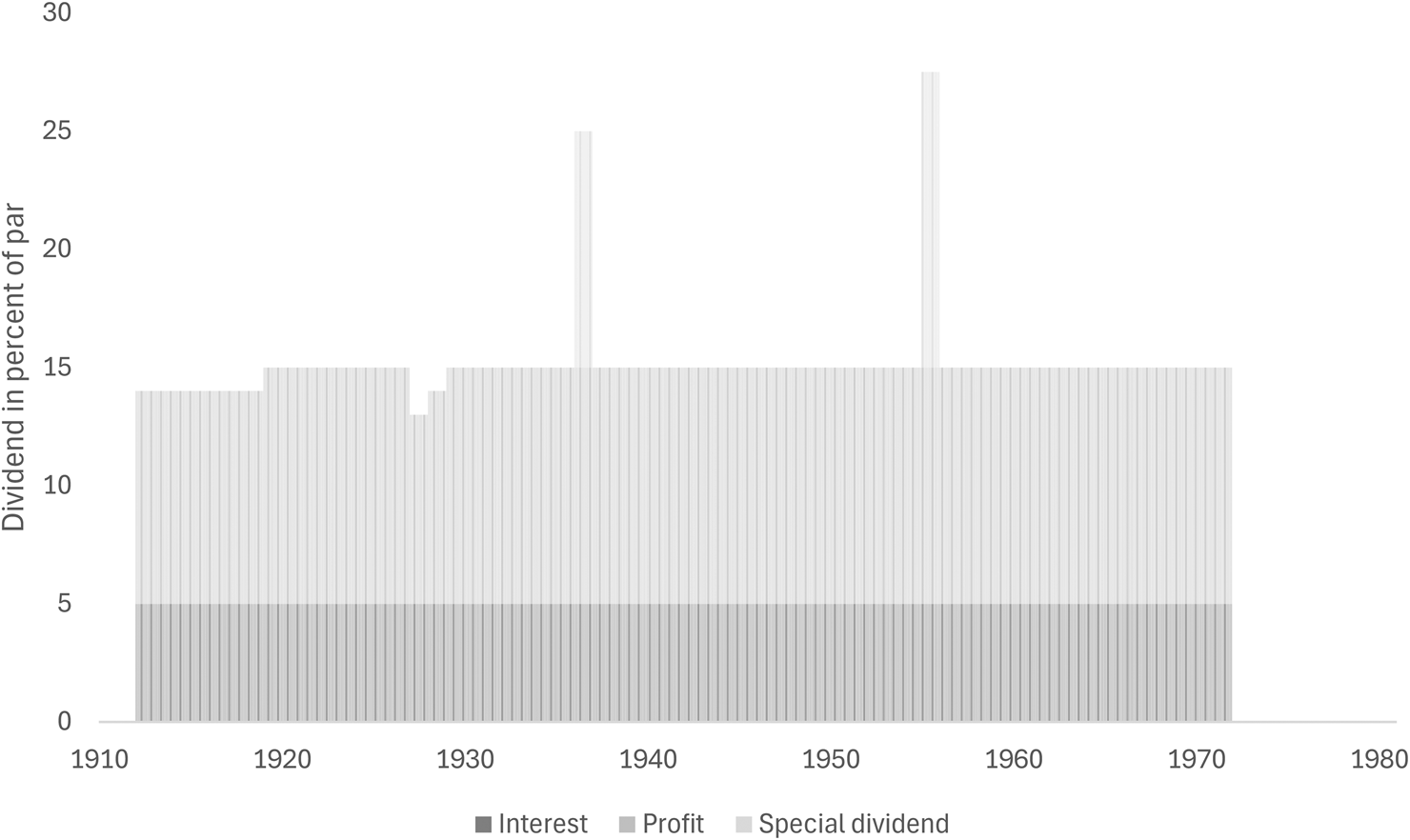
Figure 6. Dividends of Stockholms Enskilda Bank, 1912–71
Stockholms Enskilda Bank was a private bank with personal liability from 1912 to 1933 and limited liability corporation after 1933. The figure plots dividend as a percentage of par. The total dividend equals the sum of the underlying interest (dark-gray portion), profit (mid-gray portion) and the special dividend (light-gray portion). Interest is paid at the end of the fiscal year, and profit is paid at the annual general meeting following the fiscal year. The special dividend in 1956 marks the celebration of the bank's 100th anniversary.
Interest and profit vary over time and across firms, but the average interest portion is smaller and less volatile than the profit portion (Table 4). Most volatility arises from across-firm variation in interest and profit, but average within-firm standard deviation of profit 1.24 percent also exceeds the average within-firm standard deviation of interest 0.23 percent. Since interest must be pre-approved more than six months before the end of the fiscal year, committing to a low interest is conservative. The lower volatility of the interest portion also simplifies financial planning for shareholders.
Table 4. Summary statistics of interest and profit

The table provides summary statistics for 28 companies that decompose the annual dividend into interest and profit. Dividends are expressed as a percentage of par. The companies are 13 banks, nine insurance companies and six industrials. The number of observations equals the number of firm-years, when both interest and profit are paid.
VIII
Volvo stated in its annual report for 1954 that the company's dividend policy was to distribute annually 6 percent of par and to disperse additional income through stock dividends, when earned surplus were large enough to support the issuance of a round number of new shares. This dividend policy implies that the dividend per share remains constant when the company's earnings and market value increase. Consistent with the stated dividend policy, from 1938 to 1965, Volvo paid a constant dividend of 6 percent of par and distributed a total of 3.84 new shares per old initial share through a sequence of six stock dividends (Figure 7). Since the dividend per share is constant, each stock dividend results in a proportional dividend increase.
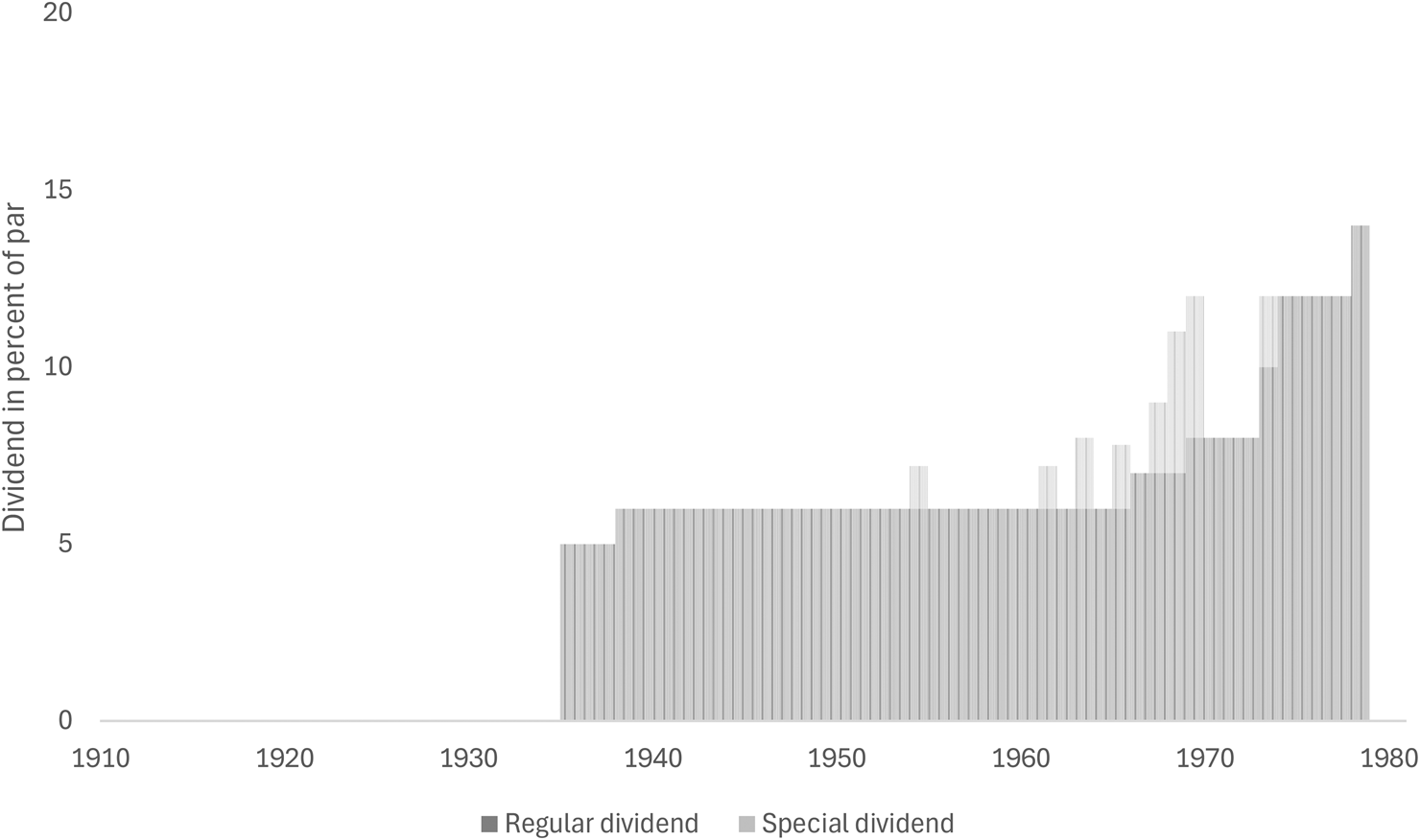
Figure 7. Dividends of Volvo, 1935–78
The figure plots dividend as a percentage of par. The total dividend equals the sum of the regular dividend (dark-gray portion) and the special dividend (light-gray portion). From 1938 to 1965, the target dividend is 6 percent of par. Volvo makes eight special dividends of which five are prepaid stock dividends and three are bonus dividends (1968, 1969 and 1973). Volvo goes public in 1935 through a spinoff from SKF.
The example of Volvo suggests that shareholders attached value to receiving a constant dividend per share. We want to know more generally how companies adjusted the dividend per share around stock dividends.
We introduce our methodology with a numerical example. A company has 100 shares outstanding. The current dividend per share equals 10 and the total dividend of the company is 1,000. The company proposes a stock dividend with a split factor of 1.25, which increases the number of shares to 125. A full downward adjustment of the dividend per share implies that total dividends do not change:
No downward adjustment of the dividend per share implies that the total dividend increases in proportion to the increase in the number of shares (25 percent):
A prepaid stock dividend thus raises the total dividend proportionally.
More generally, suppose that a stock dividend takes place between the payments of dividends in year t and t + 1. Let n t be the number of shares outstanding and D t the dividend per share in year t. The total dividend in the year t before the stock dividend equals n t × D t, and the total dividend in the year t + 1 after completing the stock dividend is n t+1 × D t+1. The change in the total dividend from year t to t + 1 equals:
If the dividend per share remains constant from year t to t + 1, the increase in the number of shares results in a proportional increase in total dividends. If the dividend per share fully adjusts downward, total dividends remain the same, and Δ = 0. Dividends are paid annually and dividends can change from one year to the next for other reasons than a change in the number of shares outstanding. We analyze the average change in total dividends over years when companies increase the number of shares outstanding.
The number of shares increases through stock dividends, rights offers, or a combination of the two. A rights offer increases the number of shares because the offer discount requires that the company issues more shares. We leave out share increases through stock splits, which result in a proportional change in the dividend per share.
On average, cash dividends increase in response to stock dividends and rights offers (Table 5). Looking across split factors, cash dividends increase proportionally to small stock dividends and partially to large stock dividends (Panel A). It is not surprising that cash dividends adjust partially to large stock dividends because both cash and stock dividends are booked against earned surplus. The dividend per share rarely changes in response to the issue discount in rights offers (Panel C). The observation that stock dividends and rights offers are associated with dividend increases is not unique for Sweden. The first event study of stock price reactions to capital operations by US firms discusses this empirical feature (Fama et al. Reference Fama, Fisher, Jensen and Roll1969).
Table 5. Dividends and number-of-share increases
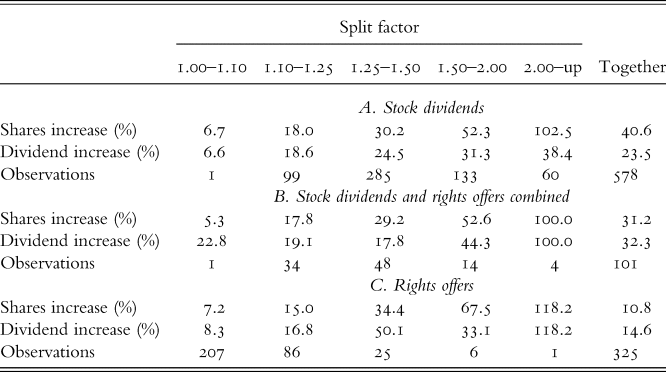
The table reports the equal-weighted average increase in the number of shares and total dividends averaged over adjacent years, when companies make a stock dividend, a rights offer, or a combination of the two. A split factor of 1.25 means that the number of shares increases by 25 percent. Panel A contains stand-alone stock dividends, Panel B combinations of stock dividends and rights offers, and Panel C stand-alone rights offers. We have eliminated all special dividends other than prepaid stock dividends from our calculations.
IX
Following Lintner (Reference Lintner1956), a large literature points out that dividends per share fluctuate less than earnings per share. This statistical feature is referred to as dividend smoothing. For completeness, we report related results for Swedish companies for the period 1912–78.
Lintner (Reference Lintner1956) specifies an econometric model that captures the speed by which dividends adjust to changes in earnings:
where D t denotes the company's gross dividends and E t the company's gross earnings. The structural parameters represent the dividend growth rate α, the speed of adjustment, λ ∈ [0, 1], and the target payout ratio, β. Following the standard procedure, we rearrange the terms and estimate the following regression equation:
where the structural parameters are recovered as:

We scale the regression by book value of assets, book value of equity, and capital (par value times the number of shares). Scaling means that the parameter α measures the difference in growth rate between gross dividends and the scalar. Unbiased estimates of the target payout ratio and the speed of adjustment require that the time-series grow at the same rate (α = 0). In the literature, the most popular scalar is the number of shares, i.e. dividend per share is regressed on earnings per share and lagged dividend per share. We do not follow this approach, as it raises additional methodological questions without moving us forward with respect to dividend smoothing. We stack the data and estimate the parameters of a pooled regression; we subtract special dividends from total dividends, but we do not separate dividends to preferred and common stocks despite the fact that dividends to limited preferred stocks are time-series constants. None of these decisions materially change any conclusions.
The speed-of-adjustment parameter is low for historical markets (Table 6). For comparison, Braggion and Moore (Reference Braggion and Moore2011) estimate the speed-of-adjustment parameter to λ = 0.81 for listed UK companies for the period 1895–1905, and Leary and Michaely (Reference Leary and Michaely2011) find that the speed-of-adjustment parameter gradually decreases from above λ = 0.60 to λ = 0.20 for listed US companies for the period 1928–80. A parameter of 0.25 means that it takes the company four years to adjust dividends to a change in earnings. The intercept is positive and statistically different from zero in all three specifications. It means that dividends grow faster than book value of assets, book value of equity and capital. The difference in growth rates between dividends and book value of assets has to do with transfers of company assets from the parent company to fully owned subsidiaries in the 1970s. As a result, book values of the assets of parent companies drop. The difference in growth rates between dividends and book value of equity is the result of an increase in book leverage over time, and the difference with respect to capital is the result of the diminishing importance of par values. The main implication of a positive intercept is that the estimated target payout ratio is too small and the speed of adjustment too large. The biases in the two structural parameter estimates becomes apparent when we estimate the regression without intercept (Panel C).
Table 6. Lintner's dividend smoothing model, 1912–78
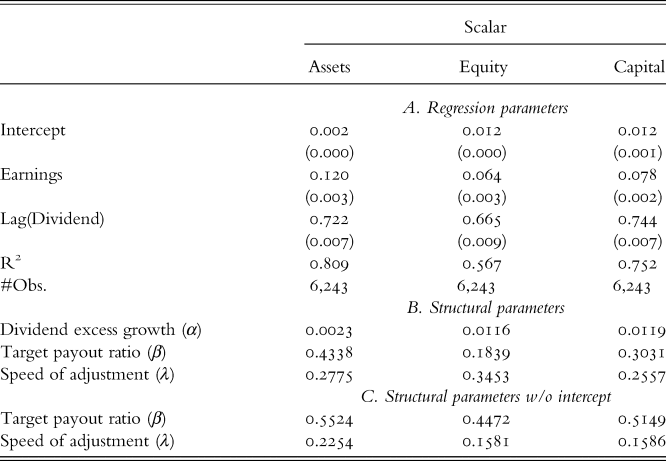
The table reports the ordinary least squares results of regressing current dividends on current earnings and lagged dividends in the pooled data set of Swedish listed companies. The numbers within parameters below the regression coefficients are standard errors. As all parameter estimates are vastly statistically significant, we omit to indicate the level of statistical significance. The structural parameters measure (i) how fast dividends grow relative to the scalar, (ii) the target payout ratio and (iii) how fast dividends adjust to a change in earnings.
X
In a perfect market setting, where investors can buy and sell shares without friction, dividend policy is irrelevant to the value of the firm (Miller and Modigliani Reference Miller and Modigliani1961). Several institutional features of our data set point to the importance of dividends: (i) shareholders reject dividend proposals from management; (ii) firms pay dividends at the same time as they sell new shares; (iii) management carefully states whether the new shares will be included or excluded from receiving the next dividend or even a portion of the next dividend; (iv) management carefully separates between regular and special dividends; and (v) some companies divide the annual dividend into interest and profit. Many theories have been proposed to explain the relevance of dividend policy. We do not intend to arbitrate between competing theories, but we would like to point out one particular market imperfection that may be relevant in historical stock markets.
A rule of thumb is to deplete a stock portfolio for consumption at the rate of 4 percent per year (Bengen Reference Bengen1994). The sample-average dividend of 8 percent of par and an average stock price of 200 percent of par imply that dividends deplete Swedish stock portfolios by exactly 4 percent per year. The alternative is to sell shares. A stock market investor with one share in their portfolio would have to deplete their entire portfolio (100 percent depletion rate) versus an investor with 25 shares in their portfolio who would deplete the desired 4 percent of their portfolio by selling one share (Figure 8). Ignoring other transaction costs, selling shares is a plausible alternative for a stock market investor with many shares in their portfolio. However, an investor with few shares cannot sell shares without ending up with a larger cash balance than they want for the simple reason that shares cannot be sold in fractions.

Figure 8. Portfolio depletion rate from dividends versus selling shares
The figure plots the portfolio depletion rate as a function of the number of shares in the portfolio under the alternatives to (i) receive a 4 percent dividend per year or (ii) sell one share. The latter rate equals one divided by the number of shares.
The subscription lists that firms must file with the Swedish Company Registration Office makes it possible to estimate the number of shares per stock portfolio. Many rights-offer participants hold fewer than 25 shares (Table 7). The tendency towards holding few shares in the stock portfolio is stronger for stocks with high prices. For example, in rights offers of stocks with offer prices from 600 kronor to 10,000 kronor, 40 percent of the participants have five shares or less. This is not surprising. At the price level of 1,000 kronor or higher, an average worker cannot buy more than four shares with their entire annual income. Even a physician in Stockholm, with a much higher annual income, would find it difficult to finance the purchase of more than 25 shares without taking out bank loans or selling other shares. In these calculations, we have ignored the fact that shareholders may participate in multiple rights offers and they may purchase additional shares in the secondary market, but we suspect that the distribution of the number of shares per investor would not shift much towards the right, if we could observe complete stock portfolios. High-income investors hold more than 25 shares, while low-income investors may find it difficult to hold the minimum number of shares that is required to purchase one new share in a single rights offer. In this environment, selling shares may not be a viable alternative to receiving dividends, which implies that dividends are preferred by many shareholders.
Table 7. Number of shares per investor in rights offers

The table reports the number of shares held by the bidders in 184 rights offers by Swedish listed companies between 1912 and 1935. Participants in rights offers must present the number of old shares that entitle them to purchase one new share. Most rights offers require two, three, four or five old shares to purchase one new share. The total number of observations is 119,000. The numbers have been rounded.
As a result of stock price management through stock splits and stock dividends, the average price per share is stationary over the entire period 1912–78. Stationarity implies that the average price per share decreases by approximately 90 percent in real terms, which means that an average worker who could afford to purchase one share in 1920 could afford to purchase 10 shares in 1978. Real income also grows at a rate of 2.3 percent per year, which means that average real income was about five times higher in 1978 (Rydqvist and Guo Reference Rydqvist and Guo2021). The combined effect of inflation and real income growth implies that a worker who could afford to purchase one share in 1920, could purchase 50 shares in 1978. These back-of-the-envelope calculations imply that the preference for dividends over selling shares to generate income loosens up over time.
XI
The fundamental purpose of financial securities is to transform current income into future income. Stock ownership generates income in the form of dividends and capital gains. Since Miller and Modigliani (Reference Miller and Modigliani1961), the academic literature has assumed that stock market investors can always generate income by selling shares. In this article, we have argued that the sale of one share of common stock may not replicate that of receiving dividends. The market imperfection we have in mind is that shares cannot be sold in fractions. This hypothesis requires further scrutiny, but some features of the dividend policy of Swedish companies cannot easily be explained by alternative theories that are based on information economics, and we have shown that many investors in Sweden own few shares. We propose that future researchers pay attention to the institutional details of dividend policy in addition to analyzing the broad patterns of stationary and predictable dividends.

